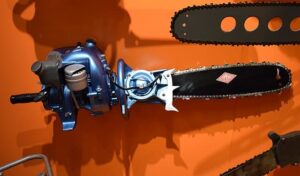As an Amazon Associate, this site earns commissions from qualifying purchases. For more information click here.
Anyone who has seen a chainsaw in use knows it can be potentially dangerous. The most common risk associated with it is the blade. But the truth is chainsaws pose other dangers such as fires, which is why you need to be careful when using it.
The sparks from a chainsaw can cause a fire. An overheating engine will smoke and could burst into flames if there is combustible material close by. Electrical chainsaws can also catch fire if there is a short circuit.
Chainsaws are powerful, but you need to use it properly to avoid accidents. Whether you are a beginner or have been using them for a while, you must always recognize the potential danger. In this guide you will learn how to protect yourself and prevent mishaps.
How a Chainsaw Can Start a Fire
There are three basic chainsaw types: gas, electric and cordless/battery powered. Each carries a possible risk.
Gas are the most vulnerable to fire because they need fuel to run. Electric chainsaws can also be a fire hazard if used in wet weather. Battery powered chainsaws are the least susceptible, but you should overcharging to be safe.

The following are the most likely reasons for a chainsaw to catch fire.
Sparks
Chainsaw sparks can cause serious injury or ignite a fire. Always safety goggles to protect yourself. In addition these sparks can also ignite fires. It is also important to buy a reliable chainsaw. Our choice is the Black+Decker 20V Max Cordless Chainsaw for its performance and reliability.
The most common reasons for chainsaw sparks are:
- The chainsaw hits something metallic. Sometimes nails and other metal objects get swallowed by trees. When the chain makes contact with a metal object, sparks will literally fly.
- Dull blade. If the chain is not sharp enough it will not be able to cut the wood. Instead the chain will strike itself causing sparks to fly off. The solution is to sharpen the chain or replace it.
- Too much pressure. Applying too much force can generate sparks. If the blade is sharp enough you don’t need to apply a lot of pressure. If you have to exert a lot of physical effort to cut the wood, there might be a problem with the engine or you need a more powerful chainsaw.
- Wrong chain tension. Chainsaw chains have to be tensioned properly for it work. Too much or too little and the blade will not run. It might work but this would require more effort and will overheat the engine.
Make certain the chain is configured correctly. This video shows you how it is done.
Overheating
Chainsaws can overheat and this always carries a potential fire risk. A gas chainsaw burns fuel as it runs and this is emitted from the exhaust. If it gets too hot it could catch fire.
The engine is another possible hazard. Just like those on a car, the one on your tool can overheat. When the engine starts smoking you should turn it off immediately. In some cases an overheating chainsaw will just stop running. But if you leave the engine and the temperature is already high, it could burst into flames.
An electric chainsaw can also be vulnerable to fire if overheated. These tools can handle heat well, but you have to be careful about its power supply. If the cord is not connected properly to the power outlet or the power source is faulty, it can cause serious problems.
How to Prevent Chainsaw Overheating
The best defense against overheating is maintenance. Here are the steps.
Let it cool down. If the chainsaw is running hotter than usual, turn it off for a few minutes and let the engine cool off. Most of the time that is enough to prevent overheating. While the tool is cooling, check the air filter if it needs cleaning or replacement.
Clean the filters and exhaust. Clean the chainsaw regularly especially the air filter. These block out dirt and debris so the engine runs smoothly.
If the air filter is dirty, it will clog the engine with dirt. Air will not be able to get in so the internal temperature will go up. Cleaning or replacing the air filter is going to help. This video shows you how it I done. Do the same with the exhaust. That is the part where the heat is expelled so it needs regular maintenance.
Lubricate the engine. An engine generates friction when it runs, and this causes wear and tear in the long term. In the short term this can lead to overheating. Lubricating the engine mitigates this and keeps the temperature lower.
Check the power cord. If you are using an electric chainsaw, make sure the power source is working. Next, plug the cord securely.
Consider using an extension if you find yourself pulling the cord to its limit. This is not only inconvenient but dangerous. The cord could snap and damage the chainsaw. Replace the cord right away if you notice any peeling or signs of wear.
Exposure to Flammable Material
Gas chainsaws should never be left with any flammable or combustible material. If the chainsaw is running there is a real risk of fire.
Flammable materials include acetone, gas, alcohol, aerosols, cooking oil, nail polish, paint thinner and turpentine among others. Keep your chainsaw away from these objects.
Exposure to these materials is dangerous even if the saw is just idling. Anytime the engine is running you have to keep it as far from flammable objects as possible. This applies to all chainsaws whether it is gas, electric or battery powered.
A Short Circuit
Short circuit can occur with any electrical equipment, and that includes electric chainsaws. Though manufacturers have installed safety measures, you can never be too careful.
In simple terms, a short circuit happens when an electrical current goes somewhere it is not supposed to. This can occur with a faulty connection or damaged wiring. A hot wire could also touch a conducive object and generate a high electrical charge.
Short circuits typically occur in old electrical systems. Before using your electrical chainsaw, make sure the power source is well insulated and that there are no fault wiring. Loose wires are also dangerous especially during a thunderstorm.
How to Prevent Chainsaw Fire
So yes, there is always a chance of fire when using a chainsaw. But you can minimize the risk by following these simple guidelines.
Read the Owner’s Manual
Your chainsaw comes with a detailed manual. Read it and follow the instructions. Use only as directed. Follow the safety tips provided and other safety precautions. You will not only protect yourself from danger, but you will also get the most out of your chainsaw.
This is an important part and should never be overlooked. A lot of potential disasters can be prevented by reading the manual and using the tool as stated there.
Perform Regular Maintenance
Your manual has a checklist of things you need to do to keep the chainsaw in good shape. Performing regular maintenance also makes the tool less of a hazard.
The to-do list may vary but should include these:
- Lubricate the engine. We recommend the Orgon Grease Gun because it is an all-purpose and efficient cleaner.
- Clean and replace vital components like air filters, spark plugs, spark arrestor, fuel filter, carburetor etc.
- Sharpen the chain when needed.
- Replace oil fuel.
- Flip the chainsaw bar so it wears out evenly.
- Inspect the screws and bolts, fasten if necessary.
- Check wires and connections if using an electric chainsaw.
Know the Limits of Your Chainsaw
Some chainsaws can cut metal but others cannot. Some models are more suited for cutting soft wood but others can handle harder material.
If you know the limits of the tool, the less chance the engine will overheat. Gas chainsaws are more powerful than electric and battery-run models so keep that in mind.
What this means is you should plan ahead before buying a chainsaw. What will you be using it for? If it is to cut a few small trees or branches, an electric chainsaw will do. If you have to cut lots of thick wood, a gas powered unit is more ideal.
How to Protect Yourself
The best way to protect yourself against chainsaw fire and other hazards is to follow the safety guidelines. Wear a helmet, chaps, safety goggles, gloves, steel toe boots and ear plugs.
Next, prepare the site. Make sure there is a clear path for the tree to fall into, and that you have a way out to retreat to in case something goes wrong.
Have a fire extinguisher nearby. Even if you have taken all the precautions, it is always better to have one ready.
Keep flammable material away. If you have additional fuel (in case you run out of power), make sure they are far from the chainsaw and your work area. Lastly use only modern chainsaws since they are built with a spark arrestor. This is important in mitigating fires and explosions.

I love the outdoors and all the tools for maintaining gardens, yards and lawns. The only thing I am more passionate about is sharing what I know about garden and outdoor equipment.


